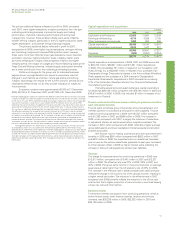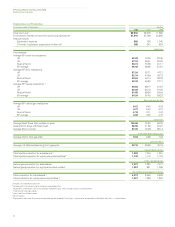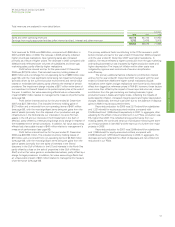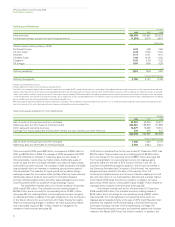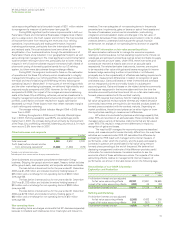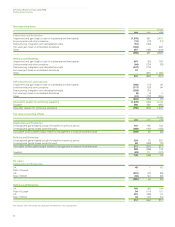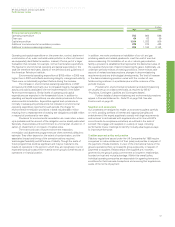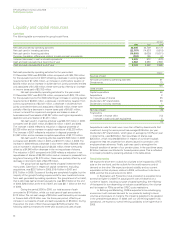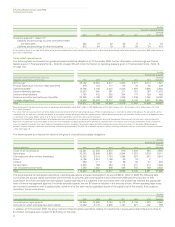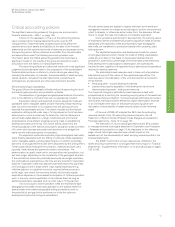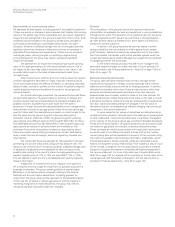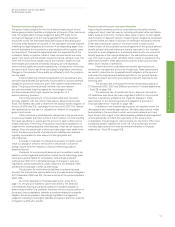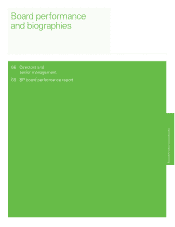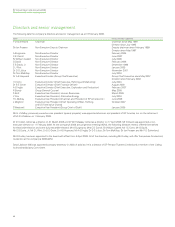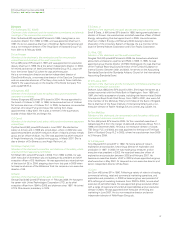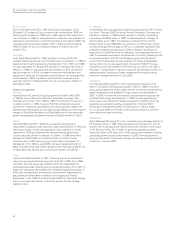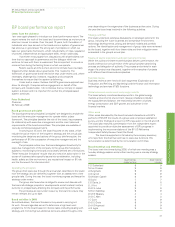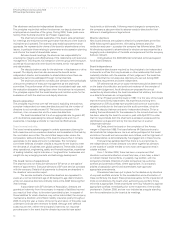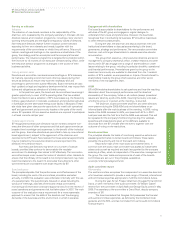BP 2008 Annual Report Download - page 62
Download and view the complete annual report
Please find page 62 of the 2008 BP annual report below. You can navigate through the pages in the report by either clicking on the pages listed below, or by using the keyword search tool below to find specific information within the annual report.
BP Annual Report and Accounts 2008
Performance review
Critical accounting policies
The significant accounting policies of the group are summarized in
Financial statements – Note 1 on page 108.
Inherent in the application of many of the accounting policies
used in preparing the financial statements is the need for BP
management to make estimates and assumptions that affect the
reported amounts of assets and liabilities at the date of the financial
statements and the reported amounts of revenues and expenses during
the reporting period. Actual outcomes could differ from the estimates
and assumptions used. The following summary provides more
information about the critical accounting policies that could have a
significant impact on the results of the group and should be read in
conjunction with the Notes on financial statements.
The accounting policies and areas that require the most significant
judgements and estimates used in the preparation of the consolidated
financial statements are in relation to oil and natural gas accounting,
including the estimation of reserves, the recoverability of asset carrying
values, taxation, derivative financial instruments, provisions and
contingencies, and pensions and other post-retirement benefits.
Oil and natural gas accounting
The group follows the successful efforts method of accounting for its oil
and natural gas exploration and production activities.
The acquisition of geological and geophysical seismic information,
prior to the discovery of proved reserves, is expensed as incurred.
Exploration licence and leasehold property acquisition costs are
capitalized within intangible assets and are reviewed at each reporting
date to confirm that there is no indication that the carrying amount
exceeds the recoverable amount. This review includes confirming that
exploration drilling is still under way or firmly planned or that it has been
determined, or work is under way to determine, that the discovery is
economically viable based on a range of technical and commercial
considerations and sufficient progress is being made on establishing
development plans and timing. If no future activity is planned, the
remaining balance of the licence and property acquisition costs is written
off. Lower value licences are pooled and amortized on a straight-line
basis over the estimated period of exploration.
For exploration wells and exploratory-type stratigraphic test wells,
costs directly associated with the drilling of wells are initially capitalized
within intangible assets, pending determination of whether potentially
economic oil and gas reserves have been discovered by the drilling effort.
These costs include employee remuneration, materials and fuel used,
rig costs, delay rentals and payments made to contractors. The
determination is usually made within one year after well completion, but
can take longer, depending on the complexity of the geological structure.
If the well did not encounter potentially economic oil and gas quantities,
the well costs are expensed as a dry hole and are reported in exploration
expense. Exploration wells that discover potentially economic quantities
of oil and gas and are in areas where major capital expenditure (e.g.
offshore platform or a pipeline) would be required before production
could begin, and where the economic viability of that major capital
expenditure depends on the successful completion of further exploration
work in the area, remain capitalized on the balance sheet as long as
additional exploration appraisal work is under way or firmly planned.
It is not unusual to have exploration wells and exploratory-type
stratigraphic test wells remaining suspended on the balance sheet for
several years while additional appraisal drilling and seismic work on
the potential oil and gas field is performed or while the optimum
development plans and timing are established.
All such carried costs are subject to regular technical, commercial and
management review on at least an annual basis to confirm the continued
intent to develop, or otherwise extract value from, the discovery. Where
this is no longer the case, the costs are immediately expensed.
Once a project is sanctioned for development, the carrying values
of exploration licence and leasehold property acquisition costs and costs
associated with exploration wells and exploratory-type stratigraphic
test wells, are transferred to production assets within property, plant
and equipment.
The capitalized exploration and development costs for proved
oil and gas properties (which include the costs of drilling unsuccessful
wells) are amortized on the basis of oil-equivalent barrels that are
produced in a period as a percentage of the estimated proved reserves.
Field development costs subject to depreciation are expenditures
incurred to date, together with approved future development expenditure
required to develop reserves.
The estimated proved reserves used in these unit-of-production
calculations vary with the nature of the capitalized expenditure. The
reserves used in the calculation of the unit-of-production amortization
are as follows:
• Producing wells – proved developed reserves.
• Licence and property acquisition, field development and future
decommissioning costs – total proved reserves.
The impact of changes in estimated proved reserves is dealt with
prospectively by amortizing the remaining carrying value of the asset over
the expected future production. If proved reserves estimates are revised
downwards, earnings could be affected by higher depreciation expense
or an immediate write-down of the property’s carrying value (see
discussion of recoverability of asset carrying values on the following
page).
At the end of 2006, BP adopted the SEC rules for estimating
reserves instead of the UK accounting rules contained in the UK
Statement of Recommended Practice. These changes are explained in
Financial statements – Note 10 on page 127.
The estimation of oil and natural gas reserves and BP’s process
to manage reserves bookings is described in Exploration and Production
– Reserves and production on page 18. As discussed on the following
page, oil and natural gas reserves have a direct impact on the
assessment of the recoverability of asset carrying values reported in the
financial statements.
The 2008 movements in proved reserves are reflected in the
tables showing movements in oil and gas reserves by region in Financial
statements – Supplementary information on oil and natural gas on pages
182 to 190.
Performance review
61


